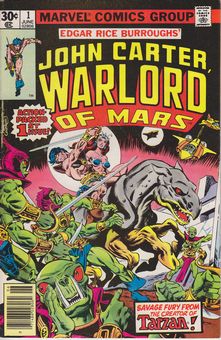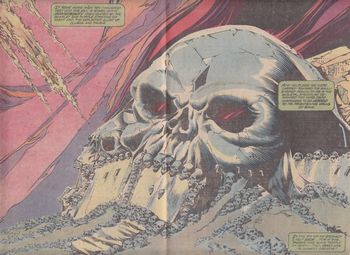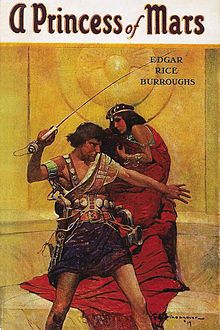no 1 the air-pirates of Mars
| série: | John Carter, warlord of Mars |
| dessinateur / scénariste: | Collectif |
| éditeur: | Marvel USA |
| genre: | Heroic-Fantasy |
| classement: | carton132 |
| date: | 1977 |
| format: | broché |
| état: | TBE/N |
| valeur: | 15 € |
| critère: | * |
| remarques: | John Carter of Mars is a serie of 28 issues, serial no 2806, from 6-1977 to 10-1979 including a special annual issue summer 1977 serial no 2070 number 1 John Carter, warlord of Mars, june 1977 the air-pirates of Mars, somehow the equivalent of Flash Gordon, John Carter's adventures develop mainly on the planet Mars, called Barsoom whereas the earth is called Jasoom, following the difference of gravity between Barsoom and Jasoom, John Carter on the planet Mars has acquired supra-natural powers (however not so much as Superman!!) he is mostly confronted with the green men of Barsoom, called the tharks or warhoon who have developed four arms and some protruding teeth like the ones of a wildboar, John Carter is constantly trying to save the heroine, Dejah Thoris, from being captured by a horde of enemies the main writer of this serie is Marv Wolfman and as an illustrator Gil Kane is the most requested one, but there are many other illustrators with different qualities, Carmene Infantino being one of the best enclosures: - cover no 1 John Carter - representative panel by artist Carmene Infantino (city of skull) - cover of novel princess of Mars by Burroughs Information A) John Carter as character John Carter was the lead character in the first novel by Edgar Rice Burroughs, set on a fictionalized version of Mars known as Barsoom, written between July and September 28, 1911, the novel was serialized as under the Moons of Mars in the pulp magazine the All-Story from February to July 1912, it later appeared as a complete novel only after the success of Burroughs' Tarzan series, for its October 1917 hardcover publication by A.C. McClurg & Company, the novel was retitled a Princess of Mars Carter reappeared in subsequent volumes of the series, most prominently in the second (the Gods of Mars, 1918), the third (the Warlord of Mars, 1919), the eighth (swords of Mars, 1936) the tenth (Llana of Gathol, 1948), and the eleventh and final instalment (John Carter of Mars, published posthumously in 1964), John Carter is also a major secondary character in the fourth volume (Thuvia, Maid of Mars, 1920) and the ninth (Synthetic Men of Mars, 1940) Carter stands 6 feet 2 inches (1.88 m) and has cose-cropped black hair and steel-grey eyes, Burroughs describes him as immortal, in the opening pages of a Princess of Mars, it is revealed that Carter can remember no childhood, having always been a man of about thirty years old, many generations have known him as "uncle Jack" but he always lived to see them grow old and die while he remained young his character and courtesy exemplify the ideals of the antebellum South, a Virginian, he served as a captain in the American Civil War on the side of the Confederacy, after the war, Carter and his companion Powell, who was also a captain in the Civil War, became gold prospectors, Carter and Powell struck it rich by finding gold in Arizona, while hiding from Apaches in a cave, he appears to die; leaving his inanimate body behind, he is mysteriously transported by a form of astral projection to the planet Mars where he finds himself re-embodied in a form identical to his earthly one accustomed to the greater gravity of Earth, he finds himself to be much stronger and more agile than the natives of Mars B) John Carter in comics John Carter, Warlord of Mars is a comics series published from 1977 by Marvel Comics, created by Marv Wolfman (writer) and Gil Kane (penciller), it was based on the Barsoom series of Edgar Rice Burroughs and featured the eponymous character. the entire series (with few exceptions) takes place between the third and fourth paragraphs of chapter 27 of Burroughs' novel a Princess of Mars. the series ran from 1977 to 1979, in 1978 it won the "Favourite New Title" Eagle Award, this serie is probably the best representative one of John Carter. Dell Comics released three issues of John Carter of Mars under its Four Color Comics banner, the issue numbers are 375, 437, and 488, and were released in 1952-1953, Gold Key Comics would reprint them as three issues in 1964, numbering one through three, but reprinted them out of order, Dark Horse Comics in 2010 reprinted the comics in a hard back archive edition. John Carter appeared in DC Comics' Tarzan comics #207-209, then Weird Worlds #1-7 and Tarzan Family 62-64 in the early 1970s, there was also a four-issue mini-series cross-over in 1996 with another of Burroughs' characters, Tarzan, in Tarzan/John Carter: Warlords of Mars from Dark Horse Comics starting in October 2010, Dynamite Entertainment has begun publishing a regular series entitled Warlord of Mars, the first two issues served as a prelude story, issues 3-9 adapted a Princess of Mars and issues 10-12 were an original story with following issues alternating between adaptation and new stories, this series ceased with #35 in 2014, accompanied by two out-of-numbering issues (#100 and #0), since 2011, a regular Dejah Thoris series and numerous mini-series were also published by IDW. in 2011, Marvel published two mini-series, John Carter: a Princess of Mars, by Roger Langridge (scripts) and Filipe Andrade (art) and John Carter: World of Mars, by Peter David (scripts) and Luke Ross (art), a prequel to the Disney Movie, in 2012, Marvel published a new miniseries entitled John Carter: Gods of Mars, based on the novel the Gods of Mars, with scripts by Sam Humphries and art by Ramon Perez. Newspaper strip in 1941, John Coleman Burroughs wrote and illustrated 69 weeks of a syndicated colour Sunday newspaper strip, John Carter of Mars, which debuted in The Chicago Sun on December 7, 1941, this debut coincided with the Japanese attack on Pearl Harbor, resulting in the series being picked up by very few papers, the strip began with a Princess of Mars adaptation but departed from the original with episode 5 John Coleman Burroughs explained that this was done at the request of United Features Syndicate, in order to provide more action in the weekly episodes. continuing with the Burroughs tradition of family involvement, John's wife, Jane Ralston Burroughs, helped with the backgrounds, inking, and lettering of the strip and even served as model for Dejah Thoris |
| couvertures: |    |
Copyright 2008 - 2025 G. Rudolf
